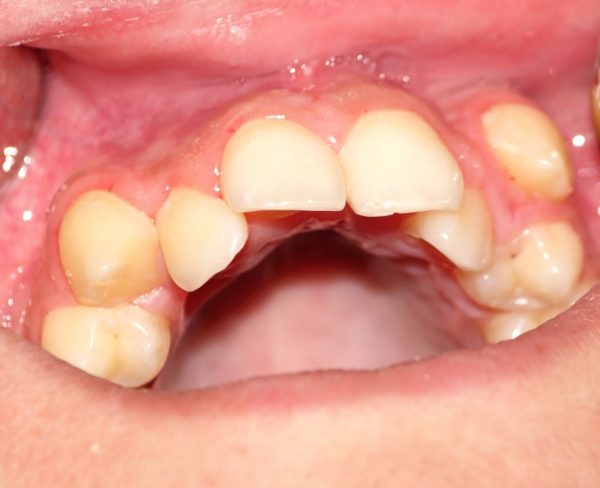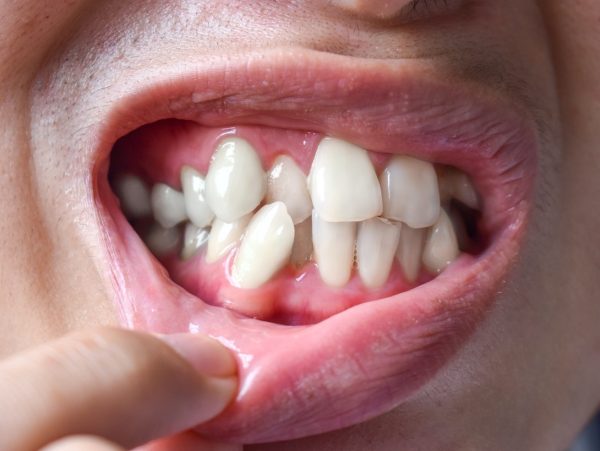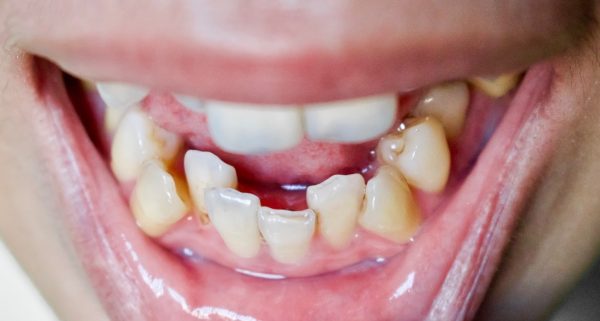Transposition malocclusion, also known as “dental transposition,” is a rare yet complex dental condition that poses unique challenges in orthodontics. At Burke & Redford Orthodontists, we specialize in treating such intricate cases, offering advanced care for children and teenagers.
Understanding Transposition Malocclusion
Transposition malocclusion occurs when two adjacent teeth exchange positions in the jawbone. This misalignment can affect bite function and dental esthetics. This rare condition requires skilled orthodontists like Dr. Redford and Dr. Burke to help treat. In some cases, transpositions require them to work together with an oral surgeon.

The Importance of Early Detection
Early detection and interceptive orthodontics are crucial in managing transposition malocclusion. This approach, focused on early intervention for children and teenagers, enables timely treatment, thereby minimizing the necessity for more invasive procedures later.
Interceptive orthodontics is a fundamental aspect of early orthodontic treatment, which plays a pivotal role in identifying and addressing dental issues like transposition malocclusion during a child’s developmental years.
- Age of Intervention: Typically beginning between the ages of 6 and 10, interceptive orthodontics involves evaluating and treating children when their jaws are still growing, and their permanent teeth are starting to emerge.
- Early Assessment: Regular orthodontic evaluations allow for the early identification of potential issues. This proactive approach is crucial in detecting transposition malocclusion before it becomes more complex.
- Preventive Measures: Interceptive treatment can involve guiding the growth of the jaw and/or eruption of teeth, correcting harmful oral habits (like thumb sucking), and addressing early bite problems. This stage often involves the use of orthodontic appliances that are specifically designed for younger patients.
- Managing Space for Teeth: Interceptive orthodontics may include space maintenance or expansion to ensure that there is enough room in the mouth for permanent teeth to emerge and align properly. This is particularly important in preventing or mitigating the effects of transposition malocclusion.
- Minimizing Treatment Complexity: By addressing issues early, interceptive orthodontics aims to reduce the need for more extensive orthodontic treatment later. This can mean shorter treatment times and less invasive procedures in the adolescent years.
- Customized Treatment Plans: Each child’s dental development is unique. Interceptive orthodontics allows orthodontists to create customized treatment plans that cater to individual needs, ensuring more effective and efficient outcomes.
- Educating Families: Part of interceptive orthodontics involves educating parents and children about oral health, the importance of maintaining good dental hygiene, and the role of regular orthodontic check-ups in monitoring and managing dental development.
By incorporating interceptive orthodontics into their practice, Burke & Redford Orthodontists ensure that young patients receive the best possible start to achieving and maintaining a healthy, aligned smile. This early intervention approach is key to simplifying future treatments and enhancing overall oral health outcomes for children and teenagers.

Diagnosing Transposition Malocclusion
At Burke & Redford Orthodontists, Dr. Ryan Redford and Dr. Michael Burke utilize the cutting-edge Planmeca ProMax 3D digital imaging system during consultations to accurately diagnose malocclusions and other dental issues. This state-of-the-art technology significantly enhances the diagnostic process in several ways:
- High-Resolution 3D Imaging: The Planmeca ProMax 3D system produces high-resolution three-dimensional images, offering a comprehensive view of the patient’s teeth, jawbone, and surrounding structures. This level of detail is crucial in identifying and assessing malocclusions, including complex cases like transposition malocclusion.
- Precision in Diagnosis: The detailed images obtained allow for precise measurements and analysis of the teeth and jaw alignment. This precision is essential in diagnosing various orthodontic problems, from simple to complex cases, ensuring that each treatment plan is accurately tailored to the patient’s needs.
- Early Detection of Issues: The clarity and depth of the images from the Planmeca ProMax 3D system enable Dr. Redford and Dr. Burke to detect orthodontic issues at an early stage, often before they become visible or problematic. This early detection is particularly beneficial in interceptive orthodontics, where timely intervention can lead to more effective treatment outcomes.
- Customized Treatment Planning: With the detailed data from the 3D images, the orthodontists can create highly customized treatment plans. This includes determining the most effective type and placement of braces or other orthodontic appliances and planning any necessary surgical procedures with greater accuracy.
- Patient Education and Involvement: The Planmeca ProMax 3D system also serves as an excellent tool for patient education. By viewing detailed images of their own dental structures, patients (and their families) can better understand their condition and the proposed treatment plan. This visual aid enhances communication and helps in building trust and confidence in the treatment process.
- Collaboration with Oral Surgeons: When surgical interventions are required, the detailed images from the Planmeca ProMax 3D system facilitate seamless collaboration with oral surgeons. This ensures a comprehensive approach to treatment, combining orthodontic and surgical expertise for optimal results.
Treatment Strategies for Transposition Malocclusion
Our treatment strategies are tailored to each patient’s needs. We specialize in self-ligating braces, which are highly effective in correcting transposition malocclusion:
– Ceramic Clear Braces: These offer a discreet treatment option, ideal for image-conscious teens. Their self-ligating mechanism allows for easier and more efficient adjustment visits.
– Damon Braces: Known for their brand-name, Damon braces also utilize a self-ligating mechanism.
– Metal Braces: Traditional yet robust, metal braces provide a reliable solution for severe cases of transposition. They are especially suitable for active children and teens. They are also available as a self-ligating option.

Additional Orthodontic Appliances and Techniques
In some instances, additional appliances or techniques may be necessary to correct transposition malocclusion. These include:
– Palatal Expanders: These devices are specifically designed to expand the upper jaw, effectively creating additional space in the mouth. This expansion can be beneficial when there are transposed teeth, as it allows extra space for rearranging the position of teeth.
By broadening the dental arch, palatal expanders facilitate the movement of teeth into their optimal positions, contributing significantly to a functional bite alignment.
– Space Maintainers: Essential when premature tooth loss has occurred, preventing neighboring teeth from shifting into the empty space.
– Extraction of Baby Teeth: Extraction of select baby teeth can help guide transposed teeth into a more favorable position, thereby making correction easier and/or avoiding more aggressive approaches.
Collaborative Approach with Oral Surgeons
For cases requiring surgical intervention, Dr. Ryan Redford and Dr. Burke work closely with reputable local oral surgeons. This collaborative approach ensures comprehensive care, addressing both orthodontic and surgical aspects of treatment.
Long-Term Benefits and Oral Health Outcomes
Treating transposition malocclusion not only improves dental esthetics but also prevents long-term oral health issues such as impaction of teeth and bite problems. Early and effective treatment plays a pivotal role in ensuring overall oral health and well-being.
Why Choose Burke & Redford Orthodontists
Dr. Ryan Redford and Dr. Michael Burke bring a wealth of expertise and a patient-focused approach to orthodontics. Our commitment to quality care and the latest orthodontic technologies makes us the preferred choice for families seeking treatment for children and teenagers.
Addressing transposition malocclusion is essential for maintaining oral health and achieving a functional, esthetic smile. We encourage families to seek early consultation for the best outcomes.
Request an Appointment with Our Office Today
For concerns about transposition malocclusion or to learn more about our brace’s treatment options, contact Burke & Redford Orthodontists. Schedule a consultation today to explore how we can help your child achieve optimal dental health.
Here are our contact details for your convenience:
Temecula Orthodontist Office
Address: 41238 Margarita Rd Ste 101, Temecula, CA 92591
Phone: (951) 699-8011
Office Hours: M-F 9:00 a.m. – 5:00 p.m.
Lake Elsinore Orthodontist Office
Address: 351 Railroad Canyon Rd Ste C, Lake Elsinore, CA 92532
Phone: (951) 699-8011
Office Hours: Open 1st and 3rd Wednesdays 1:00 p.m. – 5:00 p.m.